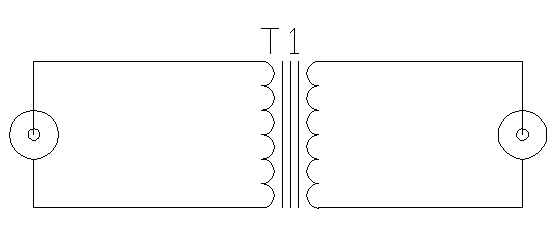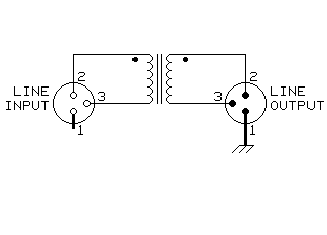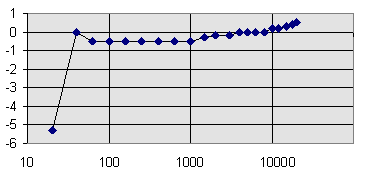How to build your own audio isolator
Building yourself an audio isolation transformers
If you want to build one yourself, you have to get two audio transformers which have 1:1 transformation ratio and greater than 1 kohm impedance. There are high quality audio transformers in the markes that meet those specs, but those can be quite expensive. Another option it to use 600:600 ohm isoltation transformers widely available for telecommunications and other uses. Those are not that high quality as good audio transformers, but can be well adequate for many not so demanding multimedia applications like computer audio if suitable transformer is selected.
Isolation for unablanced lines

Notice one thing in the transformer wiring: Many transformers have the coil starting marked with dot. If you put the audio signal to the transformer in such way that the center wire in RCA connector is always connected to the coil end marked as coil start you will get a nice isolator. If you for some reason connect the wires in one side of the transformer in the wring way, your transformer will cause a 180 degree phase shift to your audio signal. If some of the signals in your audio system will get this kind of phase shift and some other will not, you will face all kinds of sound quality prolems. If you have this kind of system, it is best to test that the audio isolation transformer will not cause unitended phase shift to the signal.
The tansformer used for this should have a flat frequency response over whole audio frequency range, should have high enough impedance at lowest frequecies and should not cause noticable distortion. If the impedance drops on low frequencies, this can cause attenuation of the lowest frequencies if the transformer is connected to the equipment which have a very high output impedance.
This kind of isoltion transformer circuit should be best connected on the receiving end (equipment input) end of the cable to get best performance. If the cable is not very long (not many meters), in practice it does not matter to which end of the cable this transformer isolation circuit is connected.
Isolation for balanced lines
For balanced lines equipped with XLR connectors the audio signals are transported between signal pins 2 and 3. So the isolation transformer should be wired so that the primary is wire between input XLR pins 2 and 3 and the secondary is wired between output XLR pins 2 and 3. The grounding pin 1 of the output XLR connector can be wired to metal case of the isolator, but do not connect the input XLR connector pin 1 to anything.

The transformer to be used in the circuit above should be 600:600 ohm audio transformer which can handle the signal levels you are about to transfer through the isolator wihtout causing too much distortion or other problems (not very low signal level microphone transformer for line signals etc.). The transformer which is used should have very flat frequency response over the whole audio frequency range (20Hz..20kHz) and even more. This kind of isoltion transformer circuit should be best connected on the receiving end (equipment input) end of the cable to get best performance. If the cable is not very long (not many meters), in practice it does not matter to which end of the cable this transformer isolation circuit is connected.
Jensen Transformers has a good application note JT-11SSP-6M 600 Ohm Line Isolation Application which deascribes how to built a very nice isolation transformer for 600 ohm balanced audio lines. Other simpler design is described at JT-11-DM Bbasic Hum Stopper Transformer isolation box. Both of the designs use more components than my simple deisgn but are expected to perform better under stron RF fields.
Circuits I have built
Circuit using telephone line transformers
I built my first isolatiors using two high quality telephone line coupling transformers which have 600 ohm impedance. This is the most commonly transformer type used in high-speed modems. Best of those are quite wideband devices (far more bandwidth than usual 300-3400 Hz as used in telephone). Using two of those transformers and few RCA connectors made quite satisfactory (but not really hifi) audio isolator. The connetion is easy: connect primary side of the transformer to one audio connector and secondary to other.
I used EOP Z1612 transformers in my test circuit and got quite acceptable frequency response of +-1 dB from 40 Hz to 20 kHz as you can see in figure below. The bass frequency below 40 Hz is not good.

The frequency measurements were made with Nacamichi T-100 Audio Analyzer and the isolator circuit was connected between it's 600 ohm output and 50 kohm input. I don't know if EOP Z1612 transformers are still available at Farnell, but you can try. If you are looking for other high quality transformers which could be a used, I would try ETAL P2001. I haven't been able to test their performance in this application, but they have proven to good transformers in other laboratory test and applications. Avoid cheapest telephone and audio transformers, because their performance is very poor at frequencies over about 5 kHz (for example Radio Shack (273-1374)).
Transformer isolation using audio transformer
One way I got my hands on the component of old cenral radio systems amplifiers. Those amplifers had a transformer isolated balanced audio input with impedance of around 1 kohm. I took the high quality input transformer from the preamplifier board and tried how well they would work in my applications. The text on the top of the transformer indicated that those transformers were 1000:1000 ohm audio transformers. The measurements showed that those transformers perform better than those telephone transformer.
I took a project box and pair of XLR connectors to make a nice set of audio isolation/balancing transformers for professional audio system. I keep those boxes with the audio wiring set and use them as problem solvers if there is some humming problem in the system which can't be easily solved in other ways.
Notes on selecting audio transformer
If you want the best sound quality (not much sound degration) you must select a good audio transformer. Any transformer of the proper ratio will give you a high impedance input, but not any transformer will sound good. Cheap transformers add distortion, mostly at low frequencies, and it's not the "good" kind of distortion. They also tend to have poor high frequency response.
Makign good audio transformers is not easy. Lower impedance transformer are generally easilier that higher impedance. High Z primary is difficult to wind because the capacitance between windings starts to become a big issue with that many turns. And that kills your high end.
There was a day when audio transformers were commodity items and they were in everything, but now they aren't so common and as a result, the cheaper ones aren't in the catalogues any more, and the better ones ccost more than they used to because there aren't the economies of scale.
If you get a cheap transformer, you will eventually get depressed with the way it sounds, and you'll be spending the money on a Jensen, a Reichenbach, Sowter, or Lundahl (or any other reputable manufacturer) anyway. So you might as well just get it now and save the wasted time effort and money.
Tomi Engdahl <[email protected]>









